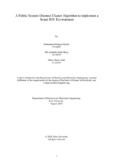| dc.contributor.advisor | Shabnam, Farzana | |
| dc.contributor.author | Haider, Mohammad Rafquat | |
| dc.contributor.author | Miraj, Md Aubdulla Oalid | |
| dc.contributor.author | Anik, Neloy Hasan | |
| dc.date.accessioned | 2021-07-13T10:50:16Z | |
| dc.date.available | 2021-07-13T10:50:16Z | |
| dc.date.copyright | 2019 | |
| dc.date.issued | 2019-08 | |
| dc.identifier.other | ID: 15310002 | |
| dc.identifier.other | ID: 16110019 | |
| dc.identifier.other | ID: 11121057 | |
| dc.identifier.uri | http://hdl.handle.net/10361/14790 | |
| dc.description | This thesis is submitted in partial fulfillment of the requirements for the degree of Bachelor of Science in Electrical and Electronic Engineering, 2019. | en_US |
| dc.description | Cataloged from PDF version of thesis. | |
| dc.description | Includes bibliographical references (pages 40-41). | |
| dc.description.abstract | The Internet of Vehicles (IOV) is a comprehensive architecture for wireless communications
between vehicle to vehicle, vehicle to human, vehicle to the road, and vehicle to the Internet.
It allows vehicles to share information, efficiency, and safety with others as well as
infrastructures using Vehicular Ad-Hoc Networks (VANET). This integration of VANET
with the Internet of Things (IoT) has made the concept of IoV an emerging technology for
smart cities for reducing car accidents, increasing car safety, creating an eco-friendly system
and more. Being a young technology, it comes with a variety of challenges and among them,
the routing protocols are a significant one that has been focused in this work. The routing
protocols have been designed concerning the IoT architecture and not IoV which offers a
significant challenge in routing packets as vehicle acting nodes are mobile and continuously
changing position making their data to vary instantaneously and periodically. This leads to
inefficient delivery of data packets from one source position to their destination. If a packet
data is transferred efficiently, then it is not effective in delivery rate; failing in long-distance
data transmission or a long delay in transmission. Routing protocols that are both efficient
and effective require huge monetary investment. Keeping in mind all three factors -
efficiency, effectiveness, and monetary resource utilization, we proposed a clustering
algorithm that is based on the weight of a particular node, and also GPS positioning of all
vehicle nodes will be used. The modern age has gifted us with vehichles; such as drones, cars
etc; that are fitted with communication sensors. We believe that our research on clustering
algorithms will provide a solution to one of the challenges of the IoV infrastructure and
would help reduce the cost significantly. Overcoming these challenges will be a big step for
not only the automotive industry but would also provide a new vision in communication
technology. We believe it would help in generating new revenues contributing to the global
economy | en_US |
| dc.description.statementofresponsibility | Mohammad Rafquat Haider | |
| dc.description.statementofresponsibility | Md Aubdulla Oalid Miraj | |
| dc.description.statementofresponsibility | Neloy Hasan Anik | |
| dc.format.extent | 41 Pages | |
| dc.language.iso | en_US | en_US |
| dc.publisher | Brac University | en_US |
| dc.rights | Brac University theses are protected by copyright. They may be viewed from this source for any purpose, but reproduction or distribution in any format is prohibited without written permission. | |
| dc.subject | Internet Of Vehicles | en_US |
| dc.subject | Cluster-head | en_US |
| dc.subject | Sub-cluster head | en_US |
| dc.subject | RSU | en_US |
| dc.subject | Packet transmission | en_US |
| dc.title | A fabric system oriented cluster algorithm to implement a smart IOV environment | en_US |
| dc.type | Thesis | en_US |
| dc.contributor.department | Department of Electrical and Electronic Engineering, Brac University | |
| dc.description.degree | B. Electrical and Electronic Engineering | |

